 First off: Hey, I’m branded. Hats off to our multitalented Dw. Dunphy for the new logo.
First off: Hey, I’m branded. Hats off to our multitalented Dw. Dunphy for the new logo.
And now…let’s go to the movie cave and spin some discs.
The biggest hit of 2015 is poised to be the blockbuster Blu-ray of 2016. Star Wars: The Force Awakens and is available to own early on digital HD and Disney Movies Anywhere today, and comes home to disc next week. Of course you want it for your collection. Even if you didn’t love the movie, it’s highly unlikely that you hated it, unlike the prequels. The film hits the sweet spot of “good” for the majority of viewers, which is rare for a production freighted with such enormous expectations. The followups and spinoffs will have different creative teams backing them, but you leave confident that the series is in more than competent hands, as you did with the first Lord of the Rings movie.
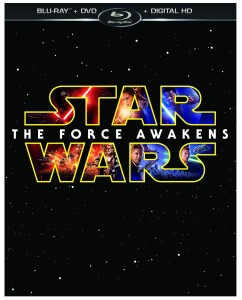 I reviewed the movie back in January. How does it look on Blu-ray? Magnificent, of course, with Dolby 7.1 audio to rock the house besides. But you figured that. (A 3D viewing option will have to wait for a future release, not that I was overly impressed with the presentation theatrically.) What else is there? Let’s review.
I reviewed the movie back in January. How does it look on Blu-ray? Magnificent, of course, with Dolby 7.1 audio to rock the house besides. But you figured that. (A 3D viewing option will have to wait for a future release, not that I was overly impressed with the presentation theatrically.) What else is there? Let’s review.
Deleted scenes: Six in all, in various states of completion. The one spotlighting Kylo Ren (Adam Driver) is the best, and there’s footage from a snow speeder chase that’s of interest, too. Still, nothing essential.
Making-of: In four parts, running about 70 minutes, and adequately detailed for a first pass at what will likely be several iterations of the movie on disc.
The table read: A four-minute glimpse at the first script run-through.
“Crafting Creatures” and “Building BB-8”: Separate segments on evolution and design, practically and digitally. ILM’s digital effects work also gets a supplement.
“The Snow Fight”: A favorite sequence is broken down, swoosh by swoosh.
John Williams: Regarding the maestro’s Oscar-nominated score and work with the series. We’re not worthy.
“Force for Change”: A segment about how the force awakened charity work.
Available on disc from your nearest cantina come Tuesday. “Chewie, we’re home.”
 The Hunger Games: Mockingjay–Part 2 has three strikes against it. No. 1: It’s the remaining half of one of those noxious “two-part franchise conclusions,” which we can blame Harry Potter for.
The Hunger Games: Mockingjay–Part 2 has three strikes against it. No. 1: It’s the remaining half of one of those noxious “two-part franchise conclusions,” which we can blame Harry Potter for.
Mitigating factor: The useless Divergent series, knocked off from The Hunger Games, has crashed and burned at its “Part 1 of 2” climax, leaving the same studio on the hook for the remainder. Lesson learned (we can only hope).
No. 2: You can’t skip through the ten (ten!) minutes of trailers on the Blu-ray. God I hate forced trailers.
Mitigating factor: Fast-forwarding, which is never fast enough.
No. 3: It’s a Hunger Games movie. I have issues.
Mitigating factor: A funny thing happened to me and The Hunger Games. I started liking them.
A change in director helped. Hunger Games director Gary Ross was out of his depth with the first, woozy, rather shoddy installment, which was lucky to have the phenomenon of Jennifer Lawrence blow up around it. Her aim was true. Francis Lawrence, a veteran of Constantine and I Am Legend, was far more comfortable in dystopia, and the series found a consistent tone, and style. Some problems remained, but they were baked in, like the casting of the pallid Josh Hutcherson as the male ingenue, Peeta. (Those names. I got over them.)
But the stories got more complicated, testing Katniss, and the audience, too. At least in terms of theatrical grosses, there was a certain attrition in returns, as Part 1 was (typically) thinly stretched to justify this second helping and favorite elements fell away. The fourth-ish part has just one “game” (a good, scary one, involving lizardly “mutts” tracking an incursion into the Capitol) and characters played by Elizabeth Banks, Stanley Tucci, and Woody Harrelson since the beginning make more fleeting appearances. Most of the film concerns Katniss’ symbiotic relationship with the two-headed President Coin (Julianne Moore) as she seeks to assassinate the ruthless Snow (Donald Sutherland), the final reckoning the series has been building toward. It’s no easy victory, with surprises and reversals along the way. While the movies have grown past their point of origin, Katniss’ “flaming costume” returns, in a poignant and unexpected manner.
It’s the little touches that add up in the biggest of the productions, with the design of the Capitol suggested by some of Hitler’s unrealized visions. You’ll learn that and more in a behind the scenes documentary lengthier than the 137-minute feature itself, which goes into every facet of the shoot. I hope your home video setup can accommodate low light levels, as this is a dark movie on several levels, one that tested my projector. (The Dolby Atmos soundtrack is a lot brighter, and explodes into plentiful surround action once the Capitol is breached.) On hand for a commentary are Francis Lawrence and producer Nina Jacobson, who among many other topics discuss working around the death of co-star Philip Seymour Hoffman, whose final scene wasn’t completed. Adroitly handled though it is, the symmetry of his characterization is lost, leaving a hole in an otherwise complete canvas.
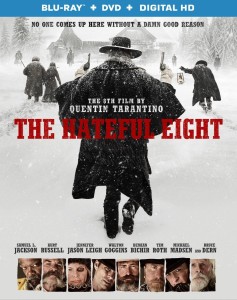 Remember how you and the kids and Grandma and Grandpa dressed in your Sunday finest, hopped in the jalopy, and drove out to the pictures to see The Hateful Eight roadshow in old-timey Ultra Panavision 70? Well, forget about replicating those golden memories of cramped cabins, bloody vomit showers, and teeth-crushing nastiness at home–what’s new on disc is the size-reduced standard theatrical version, which no one made much of a fuss over. Purists will want to hop over to Amazon France and pre-order this Region B thing, or wait for the roadshow to emerge here in Region A. I’d say probably about when QT drops the merged Kill Bill saga, which we’ve been hearing about since 2004. Patience. (Love the French title, though–Les 8 Salopards.)
Remember how you and the kids and Grandma and Grandpa dressed in your Sunday finest, hopped in the jalopy, and drove out to the pictures to see The Hateful Eight roadshow in old-timey Ultra Panavision 70? Well, forget about replicating those golden memories of cramped cabins, bloody vomit showers, and teeth-crushing nastiness at home–what’s new on disc is the size-reduced standard theatrical version, which no one made much of a fuss over. Purists will want to hop over to Amazon France and pre-order this Region B thing, or wait for the roadshow to emerge here in Region A. I’d say probably about when QT drops the merged Kill Bill saga, which we’ve been hearing about since 2004. Patience. (Love the French title, though–Les 8 Salopards.)
That said, this is an excellent translation of the program-less multiplex edition, which loses the overture, intermission, and maybe a few “bitches” and “niggers” if you can live without them. You can find Ennio Morricone’s Oscar-winning score complete on CD and iTunes, and so far as I can recall nothing horribly substantive has been removed. It’s still The Hateful Eight, minus a snarl or two, looking fantastic and with a nicely enveloping 5.1 soundtrack, and I for one wasn’t mourning trims to a movie already grievously overlong. If you feel otherwise, and obtain the Blu-ray for masochistic reasons, be prepared to wallow in Samuel L. Jackson’s promo for the movie, which, along with a puff piece making-of, constitutes the extras in their scarcity. It’s the one where Jackson ballyhoos the 65mm film shoot and the roadshow cut, the one we may never see again outside of an expensive, tchotchke-filled box set from motherfucking France. Now that’s hateful.
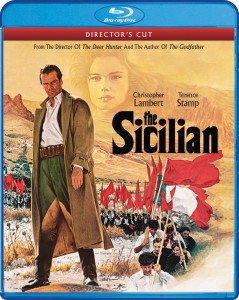 The longer director’s cut version of Michael Cimino’s The Sicilian, running 146 minutes, has erased the sour memory of the two-hour theatrical version, which I saw in an empty theater in 1987. While not as disgraceful as the shorn Once Upon a Time in America (1984), the movie was clearly hobbled by the missing footage, and amounted to more insult heaped upon injury for the filmmaker, who had a modest hit with Year of the Dragon two years earlier but never recovered from the ill-starred Heaven’s Gate (1980). The restoration of Cimino’s original vision of that movie (which was itself whittled down for an abortive theatrical run) excited critical reinterest, and however contentious it is I think it’s a masterpiece.
The longer director’s cut version of Michael Cimino’s The Sicilian, running 146 minutes, has erased the sour memory of the two-hour theatrical version, which I saw in an empty theater in 1987. While not as disgraceful as the shorn Once Upon a Time in America (1984), the movie was clearly hobbled by the missing footage, and amounted to more insult heaped upon injury for the filmmaker, who had a modest hit with Year of the Dragon two years earlier but never recovered from the ill-starred Heaven’s Gate (1980). The restoration of Cimino’s original vision of that movie (which was itself whittled down for an abortive theatrical run) excited critical reinterest, and however contentious it is I think it’s a masterpiece.
Take my word for it–The Sicilian improves on further viewings. In a fiction spun from the real-life exploits of Salvatore Giuliano, a peasant bandit who took on Sicily’s mafia, Catholic church, and aristocratic classes to bring land and bread to the poor in the 40s, Christopher Lambert (Highlander) gives a lightweight and frequently awkward starring performance. Cringeworthy, too, is the misuse of German actress and Fassbinder favorite Barbara Sukowa as a randy American duchess “from Hartford, Connecticut,” who “rapes” Guiliano in one miserably comic scene. No problems with her nudity but the actress is cruelly exposed in her dumb appearances. Screenwriting heavy hitters Steve Shagan and Gore Vidal are credited (after lawsuits flew) with the adaptation, from Mario Puzo’s novel (which, unlike the film, involved his Corleones); why they accented, rather than cut, its sillier sensationalist elements is a mystery that will have first-time viewers rolling their eyes.
Return to it again after a few years, as I did, and the movie comes together. The new Blu-ray, from an aged but acceptably grainy element, is the proper debut of Cimino’s version, at last letterboxed (2.35:1 original aspect ratio) and with Dolby 5.1 audio that carries David Mansfield’s outstanding score, its finest feature. (All his scores for Cimino are excellent.) Surrounding the hapless star is a motley but engaging collection of character actors, including John Turturro in the Fredo part, Joss Ackland as a pragmatic but sentimental don, Richard Bauer as a go-between professor, and second-billed Terence Stamp in a small role as a bemused aristo. The Sicilian landscape provides the native atmosphere the casting lacks, the action is brief but strong, and for all its wrong turns (Sukowa is pretty much gone by the midpoint, thankfully) the film is serious-minded regarding the abuses of power. I’ve adjusted to its flaws; maybe you will, too.
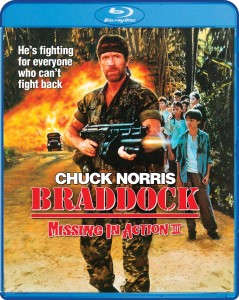 Too many crap movies for Cannon stalled Chuck Norris’ action movie career, which seemed to be going places after hits like Lone Wolf McQuade (1983) and Code of Silence (1985). 1984’s Missing in Action, which I saw at a Chicago grindhouse, was a good start for his debilitating long-term contract, but by 1988’s sequel Braddock: Missing in Action III the grindhouses, and the audiences, were gone. (In between there was a dashed-off prequel.) Directed by Norris’ brother Aaron, Braddock has the character returning to Vietnam to rescue his wife and 12-year-old son, long thought deceased, and helping more Amerasian orphans steer clear of one of his prison camp tormentors in the process. The undemanding movie is the definition of “perfunctory,” and the disc, a competent effort, has no extras. After a few more flops Norris would recapture his falling star as TV’s Walker: Texas Ranger.
Too many crap movies for Cannon stalled Chuck Norris’ action movie career, which seemed to be going places after hits like Lone Wolf McQuade (1983) and Code of Silence (1985). 1984’s Missing in Action, which I saw at a Chicago grindhouse, was a good start for his debilitating long-term contract, but by 1988’s sequel Braddock: Missing in Action III the grindhouses, and the audiences, were gone. (In between there was a dashed-off prequel.) Directed by Norris’ brother Aaron, Braddock has the character returning to Vietnam to rescue his wife and 12-year-old son, long thought deceased, and helping more Amerasian orphans steer clear of one of his prison camp tormentors in the process. The undemanding movie is the definition of “perfunctory,” and the disc, a competent effort, has no extras. After a few more flops Norris would recapture his falling star as TV’s Walker: Texas Ranger.
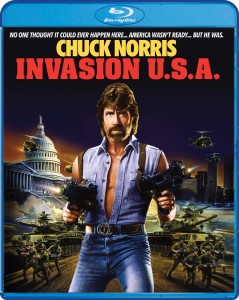 The stupidly entertaining Invasion U.S.A. (1985) is uplifted by a good transfer and a fun commentary with its director, Joseph Zito, who also helmed Missing in Action. This knockoff of the prior year’s flagwaving hit Red Dawn never gets to D.C. as promised on the poster and jacket art, contenting itself with a Mumbai-style assault on Miami (played mostly by Atlanta) led by the sniveling Soviet operative Rostov (scarred-face Richard Lynch). The movie checklists everything red-blooded Americans hated back then, including the Soviet Union, Cuba, drug smugglers, and the evergreen “war on Christmas”–literally, as a decorated suburban street and mall are leveled. For all that R-rated, CGI-free carnage, though, the movie never builds up any outrage, mostly because Rostov, neurotically obsessed with Norris’ CIA savior (imaginatively named “Hunter”), is a terrible villain, so weak he could never steal an apple off a cart, much less invade U.S.A. Equally awful is pushy female lead Melissa Prophet, as a news photographer following Chuck and clicking her camera here and there.
The stupidly entertaining Invasion U.S.A. (1985) is uplifted by a good transfer and a fun commentary with its director, Joseph Zito, who also helmed Missing in Action. This knockoff of the prior year’s flagwaving hit Red Dawn never gets to D.C. as promised on the poster and jacket art, contenting itself with a Mumbai-style assault on Miami (played mostly by Atlanta) led by the sniveling Soviet operative Rostov (scarred-face Richard Lynch). The movie checklists everything red-blooded Americans hated back then, including the Soviet Union, Cuba, drug smugglers, and the evergreen “war on Christmas”–literally, as a decorated suburban street and mall are leveled. For all that R-rated, CGI-free carnage, though, the movie never builds up any outrage, mostly because Rostov, neurotically obsessed with Norris’ CIA savior (imaginatively named “Hunter”), is a terrible villain, so weak he could never steal an apple off a cart, much less invade U.S.A. Equally awful is pushy female lead Melissa Prophet, as a news photographer following Chuck and clicking her camera here and there.
But Zito’s track, with disc extras producer Michael Felsher, is a hoot, with the director identifying the many moments where co-writer Norris’ “Chuck sense” outweighed script sense as the project evolved (James Bruner, co-writer of this and other vehicles for the actor, gets a separate interview segment) and recalling a brief panic on location when slips of paper all marked “curfew” were dropped on passers-by (only one, Norris’, was supposed to be labeled). The loose sequel, 1986’s Avenging Force, with Michael Dudikoff as Hunter, is by far the better movie (and a good Blu-ray, too) but Invasion U.S.A. shows how extras can really get a limp film on its feet.
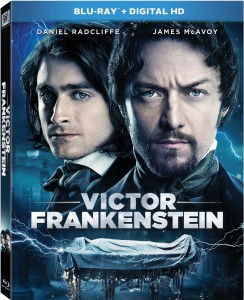 No such salvation is at hand for Victor Frankenstein, one of last year’s biggest flops. Some deleted scenes, stills galleries, and an EPK making-of, ho hum. Kind of a live action version of the forgotten cartoon Igor (2008), this casts Daniel Radcliffe as the deformed assistant to the doctor (James McAvoy), whose own knowhow regarding anatomy propels experiments in life beyond death. “Gordon,” their chimp monster, is kind of neat, and the disc doesn’t lack for thundery sound effects and the like, but mostly this is a stitched-together rehash of other, better Frankenstein movies, done in the hectic retro-CGI style of Sherlock Holmes (2009). Charles Dance, co-star of the similarly bloodless Dracula Untold, appears. Though Victor Frankenstein isn’t part of it, pulses aren’t exactly racing at the prospect of a “Monster-verse,” which Tom Cruise and The Mummy will join next year.
No such salvation is at hand for Victor Frankenstein, one of last year’s biggest flops. Some deleted scenes, stills galleries, and an EPK making-of, ho hum. Kind of a live action version of the forgotten cartoon Igor (2008), this casts Daniel Radcliffe as the deformed assistant to the doctor (James McAvoy), whose own knowhow regarding anatomy propels experiments in life beyond death. “Gordon,” their chimp monster, is kind of neat, and the disc doesn’t lack for thundery sound effects and the like, but mostly this is a stitched-together rehash of other, better Frankenstein movies, done in the hectic retro-CGI style of Sherlock Holmes (2009). Charles Dance, co-star of the similarly bloodless Dracula Untold, appears. Though Victor Frankenstein isn’t part of it, pulses aren’t exactly racing at the prospect of a “Monster-verse,” which Tom Cruise and The Mummy will join next year.
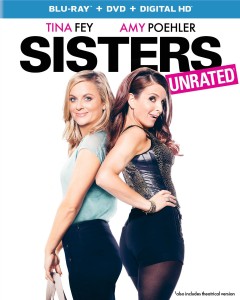 As Sisters, Tina Fey and Amy Poehler held their own against The Force Awakens, and the movie proved a mid-sized hit. It’s the kind of slight but engaging fare that has a decent afterlife, particularly on cable, where you can’t recall seeing it before and watch until something rings a bell. The two stars, sisters under the skin, kill at awards shows and bring as much to the party as possible, in a story about middle-aged sibs throwing one last bash at the family home before mom and dad (Dianne Wiest and James Brolin) sell the place. Maya Rudolph, John Leguizamo, and John Cena tag along, the last reminding you of Trainwreck, another femme-centered success where he showed himself to be beyond embarrassment. Like Amy Schumer’s vehicle, it’s too long (particularly in the “unrated” cut) and doesn’t know where to end, taxing goodwill. But you’ll want to watch it at least twice, to hear the two stars, director Jason Moore, and screenwriter Paula Pell cut up in their audio commentary, and there are a lot of outtakes and a gag reel, among other bonuses, to keep the Blu-ray chugging along.
As Sisters, Tina Fey and Amy Poehler held their own against The Force Awakens, and the movie proved a mid-sized hit. It’s the kind of slight but engaging fare that has a decent afterlife, particularly on cable, where you can’t recall seeing it before and watch until something rings a bell. The two stars, sisters under the skin, kill at awards shows and bring as much to the party as possible, in a story about middle-aged sibs throwing one last bash at the family home before mom and dad (Dianne Wiest and James Brolin) sell the place. Maya Rudolph, John Leguizamo, and John Cena tag along, the last reminding you of Trainwreck, another femme-centered success where he showed himself to be beyond embarrassment. Like Amy Schumer’s vehicle, it’s too long (particularly in the “unrated” cut) and doesn’t know where to end, taxing goodwill. But you’ll want to watch it at least twice, to hear the two stars, director Jason Moore, and screenwriter Paula Pell cut up in their audio commentary, and there are a lot of outtakes and a gag reel, among other bonuses, to keep the Blu-ray chugging along.
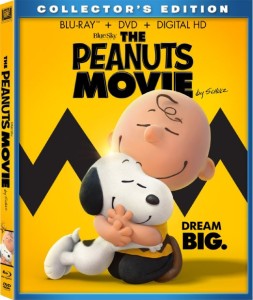 Finally, The Peanuts Movie. It charmed me once, and works equally as well at home, with an eye-poppingly gorgeous transfer and some nice audio effects, but nothing too outrageous to upset the Schulz-ian mood. Extras include an informative making-of, art galleries, Meghan Trainor (and other) music videos, and some “learn to draw the characters” lessons that I’m still trying to get right. My package came with a Snoopy stuffy that, good grief, my son promptly absconded with. Dude, that’s a pretty salopard thing to do to Daddy, and I want it back.
Finally, The Peanuts Movie. It charmed me once, and works equally as well at home, with an eye-poppingly gorgeous transfer and some nice audio effects, but nothing too outrageous to upset the Schulz-ian mood. Extras include an informative making-of, art galleries, Meghan Trainor (and other) music videos, and some “learn to draw the characters” lessons that I’m still trying to get right. My package came with a Snoopy stuffy that, good grief, my son promptly absconded with. Dude, that’s a pretty salopard thing to do to Daddy, and I want it back.





Comments